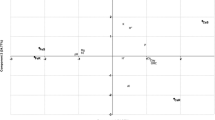Abstract
In a survey ofAzospirillum spp. on the roots and associated soil of wheat grown in eastern Australia, azospirilla were isolated from approximately 40% of samples from areas of soil pH between 5.0 and 6.6. However, azospirilla isolates were rare in soil between pH 4.5 and 5.0 and absent below pH 4.5. Of 25 independent isolates, 17 wereA. brasiliense and eight wereA. lipoferum. No selection forA. brasiliense Nir− strains by wheat roots was observed. Only one of six endorhizosphere isolates wereA. brasiliense Nir−, compared with three of nine from unsterilized roots plus associated soil, and three of eight from soil. With a medium buffered with 0.05 M malate and 0.05 M phosphate, it was found that allAzospirillum isolates had a lower minimum pH for growth when supplied with fixed nitrogen than when grown under nitrogen-fixing conditions. Strains isolated from soils had a minimum pH for growth that was less than the pH of the soil from which they were isolated. However, a significant proportion of strains isolated from roots had a minimum pH for growth that was higher than the pH of the associated soil suggesting that the wheat roots provided an ecological niche protecting against soil acidity.
Similar content being viewed by others
References
Alexander M (1980) Effects of acidity on microorganisms and microbial processes in soils. In: Hutchinson T, Havas M (eds) Effects of acid precipitation on terrestrial ecosystems. Plenum Publishing Corp, New York, pp 363–364
Baldani JI, Baldani VLD, Seldin L, Döbereiner J (1986) Characterization ofHerbaspirillum seropedicae gen. nov., sp. nov., a root-associated N2-fixing bacterium. Int J Syst Bacteriol 36:86–93
Baldani VLD, Baldani JI, Döbereiner J (1983) Effects ofAzospirillum inoculation on root infection and nitrogen incorporation in wheat. Can J Microbiol 29:924–929
Baldani VLD, Döbereiner J (1980) Host-plant specificity in the infection of cereals withAzospirillum spp. Soil Biol Biochem 12:433–439
Boddey RM, Baldani VLD, Baldani JI, Döbereiner J (1986) Effect of inoculation ofAzospirillum spp. on the nitrogen assimilation of field grown wheat. Pl Soil 95:109–121
Das A, Mishra AK (1983) Utilization of fructose byAzospirillum brasilense. Can J Microbiol 29:1213–1217
Döbereiner J (1983) Ten yearsAzospirillum. In: Klingmüller W (ed) Azospirillum II. Genetics, physiology and ecology. Birkhäuser Verlag, Basel, pp 9–23
Fåhraeus G (1957) The infection of clover root hairs by nodule bacteria, studied by a simple glass slide technique. J Gen Microbiol 16:374–381
Halsall DM, Turner GL, Gibson AH (1985) Straw and xylan utilization by pure cultures of nitrogen-fixingAzospirillum spp. Appl Environ Microbiol 49:423–428
Hegazi NA, Khawas H, Monib M (1981) Inoculation of wheat withAzospirillum under Egyptian conditions. In: Gibson AH, Newton WE (eds) Current perspectives in nitrogen fixation. Australian Academy of Science, Canberra, p 493
Hegazi NA, Saleh H (1985) Possible contribution ofAzospirillum spp. to the nutritional status of wheat plants grown in sandy soil. In: Klingmüller W (ed) Azospirillum III, genetics, physiology, ecology. Springer-Verlag, Berlin, pp 189–202
Jain DK, Patriquin DG (1984) Root hair deformation, bacterial attachment, and plant growth in wheat-Azospirillum associations. Appl Environ Microbiol 48:1208–1213
Kapulnik Y, Sarig S, Nur I, Okon Y (1983) Effect ofAzospirillum inoculum on yield of field-grown wheat. Can J Microbiol 29:895–899
Kennedy IR (1986) Acid soil and acid rain: The impact on the environment of nitrogen and sulphur cycling. Research Studies Press/John Wiley and Sons, Chichester
Keyser HH, Munns DN (1979) Tolerance of rhizobia to acidity, aluminum and phosphate. Soil Sci Soc Am J 43:519–523
Krieg NR, Döbereiner J (1984). GenusAzospirillum Tarrand, Krieg and Döbereiner 1979, 79AL (effective publication: Tarrand, Krieg and Döbereiner 1978, 978). In: Krieg NR (ed) Bergey's manual of systematic bacteriology, vol. 1. Williams and Wilkins, Baltimore, pp 94–104
Kucey RMN (1988) Plant growth-altering effects ofAzospirillum brasilense andBacillus C-11 -25 on two wheat cultivars. J Appl Bacteriol 64:187–196
Millet E, Avivi Y, Feldman M (1984) Yield response of various wheat genotypes to inoculation withAzospirillum brasilense. Pl Soil 80:261–266
Rai SN, Gaur AC (1982) Nitrogen fixation byAzospirillum spp. and effect ofAzospirillum lipoferum on the yield and N-uptake of wheat crop. Pl Soil 69:233–238
Rodriguez Caceres FA (1982) An improved medium for the isolation ofAzospirillum spp. Appl Environ Microbiol 44:990–991
Smith RL, Schank SC (1981) Factors affecting nitrogenase activity in grass field plots. In: Gibson AH, Newton WE (eds) Current perspectives in nitrogen fixation. Australian Academy of Science, Canberra, p 495
Tarrand JJ, Krieg NR, Döbereiner J (1978) A taxonomic study of theSpirillum lipoferum group, with descriptions of a new genus,Azospirillum gen. nov. and two species,Azospirillum lipoferum (Beijerinck) comb. nov. andAzospirillum brasilense sp. nov. Can J Microbiol 24:967–980
Vlassak K, Reynders L (1981)Azospirillum rhizocoenoses in agricultural practice. In: Gibson AH, Newton WE (eds) Current perspectives in nitrogen fixation. Australian Academy of Science, Canberra, p 494
Author information
Authors and Affiliations
Rights and permissions
About this article
Cite this article
New, P.B., Kennedy, I.R. Regional distribution and pH sensitivity ofAzospirillum associated with wheat roots in Eastern Australia. Microb Ecol 17, 299–309 (1989). https://doi.org/10.1007/BF02012842
Issue Date:
DOI: https://doi.org/10.1007/BF02012842




